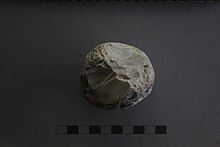Schlagstein (archeology)
Hammer stones (also called knock stones) consist of raw rock or quartzite without further processing. They were selected based on shape, weight and manageability. Also cores of flint, runners of grinding or Reibsteinen, or waste and scrap pieces of device production have been used as impact stone. Usually they are round, rounded or cylindrical and have two striking surfaces. Handle dents were sometimes made for better handling. The impact marks (impact scars) are located in one or two main impact zones, but can also be distributed over the stone. A long service life leads to the approximation of a spherical shape.
Hammer stones work by direct impact, stone on stone or via intermediate pieces made of ivory, antlers or bones to achieve cuts . They are also used to retouch, pulverize (dyes), grind (seeds) or smash hard-shelled fruits, bones or mussels. Hammer stones were used from the early Oldowan to the end of the Iron Age .
Experimental archeology comes to the conclusion that striking stones made of flint or similar hard materials are unsuitable for working flint. While tough, relatively soft rocks are well suited as impact devices. These can absorb part of the impact energy without breaking, similar to impact devices made of bones , antlers or other organic materials. Hammer stones for working flint are almost without exception made of tough rock.
Flint impact devices were used to trim and roughen grinding stone surfaces, as well as to trim rock tools such as adze blades by pecking. Knocking marks can also occur during other activities, for example when soft-patting organic materials.
literature
- Joachim Hahn : Recognizing and determining stone and bone artifacts: Introduction to artifact morphology. Archaeologica Venatoria 10, revised 2nd edition, Tübingen 1993
- Jürgen Weiner: Typology and technology of stone artifacts from the ancient Egyptian chert mining area in Wadi el-Sheikh, Egypt , in: Der Anschnitt, magazine for art and culture in mining, 2011, issue 4–5, p. 132
- Stefan Unser: The flint technology of the Stone Age. Schillinger, Freiburg 1983, ISBN 3-921340-88-8 .
- François Bordes: Hand ax and mammoth - The Paleolithic. Kindler, Munich 1968.

